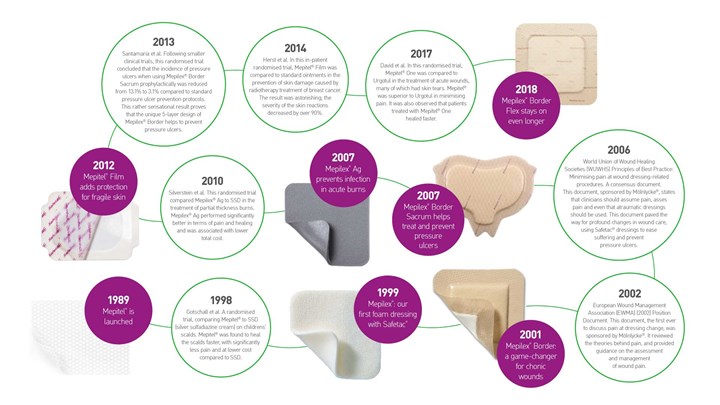The technology that changed wound care forever
Safetac®’s journey all began with a man named Tomas Fabo. In the mid-1980s, he was a young product developer working in the research and development department of Mölnlycke®’s wound care division.

At this time, the company’s wound care portfolio was made up of conventional products like Mesalt®, Mepore®, MeZink® and Mesorb®. Fabo belonged to a team of just a handful of people and the Wound Care division’s turnover was a fraction of what it is today.
Back then, Tomas was out on the field seeking inspiration for product development, observing patients as their dressings were being changed. Among the many observations he made, one thing that struck and never truly left him was the way patients suffered during dressing changes. He was haunted by the sight of grown men crying and children having to be sedated – all because of the pain.
This gave Tomas a true sense of urgency and purpose. Despite limited resources, he continued experimenting, feeling that he somehow owed it to these patients. During these experiments, he came upon some test tubes with an interesting sticky substance which turned out to be silicone.
He started to experiment with this. The story goes that he did a lot of the work in his own kitchen -- dipping scraps of his daughter’s stockings in melted silicone, curing the material in his own oven until finally, Mepitel® was born in May 1989. Mepitel’s promise was wonderfully simple: it wouldn’t stick to the wound or damage the skin and because of this, it wouldn’t hurt when removed.

Mölnlycke presented the market with a dressing addressing a problem that left most clinicians at a loss. While healthcare professionals were obviously aware of the pain dressings inflicted on patients, many felt powerless to help. In addition, we charged roughly 20 times more than the market standard, making sales slow and the first years an uphill battle. In the early days, the question came up every year: should the company continue producing Mepitel® or not? Some people literally cried in meetings, trying to stop Mepitel from being discontinued.
In the mid-90s, Mölnlycke finally decided to keep Mepitel® once and for all – even deciding to expand the offer. The gentle adhesive of Mepitel was melded to a soft and conformable foam, and in 1999 Mepilex® was launched. At this time, the company also decided to brand the adhesive itself as Safetac®.
In 2001, we launched Mepilex® Border, an all-in-one dressing with Safetac® – and excellent exudate management properties. Like Mepitel®, this product was a true game changer for Mölnlycke – and for wound care as the world knew it.
In the years that followed, additional versions of dressings with Safetac® was launched. Versions included the Lite variant, transfer dressings and silver-infused dressings like Mepilex® Ag. Mepilex Ag paved the way for our success in the US, significantly changing standards of care for burn patients. And with the advent of Mepilex® Border Sacrum, we went beyond healing and built evidence on how pressure ulcers could be prevented.
With products, evidence and opinion building, Mölnlycke Health Care has changed wound care forever. Since the launch of Mepitel® in May 1989, we have sold well over 4 billion dressings with Safetac®, helping create a less painful healing experience for perhaps 100 million people – and prevented hundreds of thousands of pressure ulcers. Tomas Fabo’s invention, a dressing adhesive that takes the unnecessary suffering out of wound care, has made Mölnlycke what it is today.
This is who Mölnlycke is. This made us and shaped us into who we are today. Let us keep this in mind as we head into the future. We encourage all of our colleagues to keep the same caring, inventive spark going. This passion we have for meeting customers’ needs will guide us in always innovating, and help us maintain our position as a guiding pioneer in the world of wound care.

















